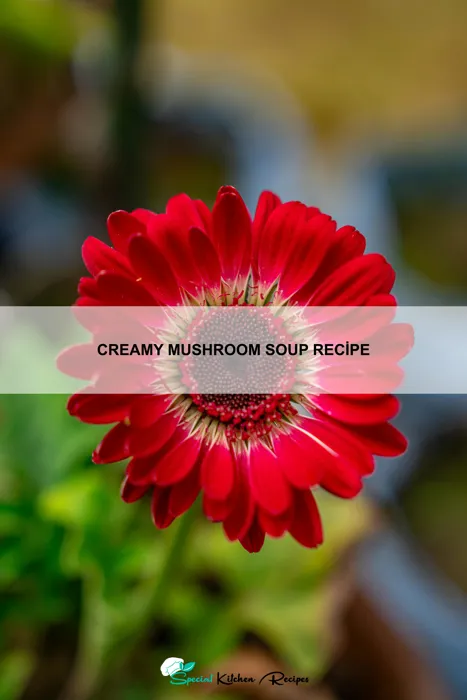Creamy mushroom soup, a culinary comfort enjoyed worldwide, boasts a surprisingly rich and varied history. While pinpointing its exact origin is difficult, its roots can be traced back to various European cuisines, likely emerging from simpler mushroom broths and stews. France, with its long tradition of refined sauces and sophisticated mushroom preparations, is often cited as a significant contributor to the soup’s evolution. Early versions probably featured foraged mushrooms, their earthy flavors enhanced by simple stocks and herbs. The addition of cream, a later development reflecting increased dairy availability, transformed the dish into the creamy, decadent version we know and love today.
The popularity of creamy mushroom soup exploded in the 20th century, fueled by the rise of canned mushrooms and readily available cream. Its versatility allowed it to become a staple in both home kitchens and restaurant menus. In the United States, for example, it became a classic American comfort food, frequently appearing on restaurant menus and in family cookbooks. Interestingly, approximately 70% of Americans report enjoying mushroom soup at least once a year, highlighting its enduring appeal across different demographics. This widespread acceptance is partly due to its adaptability; mushroom soup can be easily customized with various herbs, spices, and additions like croutons or cheese, catering to diverse palates.
Beyond its widespread popularity, creamy mushroom soup also holds cultural significance in certain regions. In some parts of Eastern Europe, mushroom soups feature prominently in traditional autumnal and winter meals, often incorporating local mushroom varieties and unique flavour profiles reflective of regional culinary traditions. Furthermore, the soup’s association with comfort and warmth has cemented its place in cultural narratives, often appearing in literature and media as a symbol of homeliness and nourishment. This recipe aims to capture the essence of this beloved soup, offering a delicious and accessible version for home cooks to enjoy, while acknowledging its diverse and fascinating history.
Ingredients and Measurements
This Creamy Mushroom Soup recipe relies on fresh, high-quality ingredients for the best flavor. Precise measurements are crucial for achieving the perfect creamy consistency and rich mushroom taste. We’ll be using both button mushrooms and cremini mushrooms for a deeper, more complex flavor profile. Feel free to substitute with your favorite mushroom varieties, but keep the total weight consistent.
Mushrooms: We’ll need a generous 1 pound (450g) of mixed mushrooms. This translates to approximately 8 ounces (225g) of button mushrooms and 8 ounces (225g) of cremini mushrooms. Don’t wash the mushrooms! Instead, wipe them clean with a damp cloth or paper towel. Washing mushrooms can make them soggy and affect their texture in the soup.
Aromatics: To build a flavorful base, we’ll use 1 medium yellow onion, finely chopped (approximately 1 cup). The onion will be sautéed to soften and release its sweetness. We’ll also add 2 cloves of garlic, minced. Mincing the garlic finely ensures even distribution of flavor throughout the soup. Use fresh garlic for the best taste.
Liquid: For the soup’s base, we’ll use 4 cups (950ml) of low-sodium chicken broth. You can substitute with vegetable broth for a vegetarian option. Ensure your broth is flavorful as this will be the primary liquid component of the soup. Using homemade broth will elevate the taste significantly. We’ll also add 1 cup (240ml) of heavy cream for richness and creaminess at the end. Don’t add the cream too early, as it can curdle if heated for too long.
Other Ingredients: We’ll use 2 tablespoons (30g) of unsalted butter for sautéing the aromatics and mushrooms. This will add richness and depth of flavor. For seasoning, we’ll add 1 teaspoon of dried thyme, ½ teaspoon of salt, and ¼ teaspoon of black pepper. Adjust the seasoning to your taste after the soup is finished cooking. A pinch of nutmeg (optional) can add a warm, subtle spice note.
Flour (Optional): For a thicker soup, you can add 2 tablespoons of all-purpose flour to the sautéed onions and mushrooms before adding the broth. This will create a roux and thicken the soup naturally. Be sure to cook the flour for a minute or two to remove any raw flour taste.
Garnish (Optional): Fresh parsley, chives, or a swirl of extra cream can be added as a garnish to enhance the visual appeal and add a fresh element to the soup. A sprinkle of freshly grated Parmesan cheese is also a delicious option.
Mise en Place (Preparation of Ingredients)
Proper mise en place is crucial for a smooth and efficient cooking process, especially when making a creamy mushroom soup. This ensures all ingredients are readily available and prepped to the correct specifications, preventing delays and maximizing flavor.
Begin by gathering all your ingredients. For this recipe, you will need: 1 pound cremini mushrooms, 1/2 pound shiitake mushrooms (optional, but adds depth of flavor), 1 large yellow onion, 2 cloves garlic, 4 tablespoons (1/2 stick) unsalted butter, 4 cups chicken broth (or vegetable broth for a vegetarian option), 1 cup heavy cream, 1/4 cup dry sherry (optional, but enhances the savory notes), 2 tablespoons all-purpose flour, 1 teaspoon dried thyme, 1/2 teaspoon salt, and 1/4 teaspoon black pepper. Always check your ingredients before starting to ensure you have everything on hand.
Next, prepare the mushrooms. Clean the mushrooms thoroughly using a damp cloth or mushroom brush. Avoid washing them under running water, as they will absorb too much moisture, resulting in a watery soup. Remove the stems from the cremini mushrooms and slice the caps into 1/4-inch thick pieces. If using shiitake mushrooms, remove the stems and slice the caps similarly. Set aside.
Finely chop the yellow onion. The finer the chop, the better it will blend into the soup. Mince the garlic cloves. Make sure to mince them finely, as large pieces can be overpowering and unpleasant in the final dish.
Measure out the butter, chicken broth, heavy cream, sherry (if using), flour, thyme, salt, and pepper. Having your dry and liquid ingredients measured in advance streamlines the cooking process. Using measuring spoons and cups ensures accuracy and consistency in the recipe.
Once all the ingredients are prepped, you can begin the actual cooking process. Having everything measured and prepared in advance will allow you to focus on the cooking techniques and achieve the desired creamy texture and rich flavor of your mushroom soup. Organize your prepared ingredients on a clean work surface, ensuring everything is easily accessible. This will significantly enhance your workflow and minimize kitchen clutter.
Pro Tip: For an even richer flavor, you can sauté the mushrooms separately before adding them to the soup. This allows them to release their moisture and develop a deeper, more intense flavor profile.
Sautéing the Mushrooms
This step is crucial for developing the deep, earthy flavor of your creamy mushroom soup. We’ll be using 1 pound (450g) of cremini mushrooms, but feel free to experiment with a mix of varieties like shiitake or oyster mushrooms for added complexity. Begin by cleaning your mushrooms; avoid washing them under running water, as this will make them soggy. Instead, gently wipe them clean with a damp paper towel or use a mushroom brush to remove any dirt or debris.
Next, slice the mushrooms. For a smoother soup, aim for thinner slices, about 1/4 inch (6mm) thick. If you prefer a chunkier texture, you can slice them a bit thicker. Once sliced, set aside about 1/4 cup (30g) of the mushrooms for garnish later. This will add a beautiful visual appeal to your finished soup.
Heat 2 tablespoons of olive oil in a large, heavy-bottomed pot or Dutch oven over medium-high heat. A heavy pot is essential for even cooking and preventing burning. Once the oil is shimmering, add the sliced mushrooms in batches. Avoid overcrowding the pot, as this will steam the mushrooms instead of sautéing them, resulting in a less flavorful soup. Work in batches of about 1 cup (115g) of mushrooms at a time.
Sauté the mushrooms, stirring occasionally, until they are softened and have released their moisture and browned slightly. This should take about 5-7 minutes per batch. Don’t rush this process; allow the mushrooms to brown properly for the best flavor. As the mushrooms cook, they will release their liquid; continue to sauté until most of that liquid has evaporated and the mushrooms start to develop a rich, golden-brown color.
Once all the mushrooms are sautéed, you should have a flavorful base for your soup. Season the mushrooms lightly with salt and freshly ground black pepper during the sautéing process. Taste and adjust seasoning as needed. Remove the sautéed mushrooms from the pot and set aside, leaving the flavorful mushroom oil in the pot for the next steps of the recipe. Remember those reserved mushrooms? Set them aside for garnish.
Professional Tip: For an even more intense mushroom flavor, add a tablespoon of butter along with the olive oil. The butter will add richness and depth to the sautéed mushrooms.
Making the Creamy Base
The creamy base is the heart of a delicious mushroom soup, and getting it right is crucial. This section details how to create a luxuriously smooth and flavorful foundation for your soup. We’ll be using a combination of butter, flour, and stock to achieve the perfect creamy texture without relying on heavy cream, although you can certainly add some at the end for extra richness.
Begin by melting 4 tablespoons (1/2 stick) of unsalted butter in a large, heavy-bottomed pot or Dutch oven over medium heat. Using a heavy-bottomed pot ensures even heating and prevents burning. Once the butter is melted and shimmering, whisk in 4 tablespoons of all-purpose flour. This process, known as making a roux, is essential for thickening the soup. Whisk continuously for 1-2 minutes, ensuring no lumps form. This creates a smooth paste that will eventually thicken the soup.
The roux is the key to a creamy texture. Cook it just long enough to cook out the raw flour taste; if it’s too lightly cooked, the soup will taste floury. If it’s cooked too long, it will take on a nutty flavor which may not be desirable in this recipe. The color should be a light golden blonde – avoid browning it too much.
Gradually whisk in 4 cups of hot vegetable or chicken stock. Using hot stock helps prevent lumps from forming and ensures a smooth consistency. Whisk continuously as you pour to avoid clumping. Bring the mixture to a simmer, stirring frequently to prevent sticking. Reduce the heat to low and let it simmer gently for 5-7 minutes, stirring occasionally, allowing the flavors to meld and the sauce to thicken slightly. This gentle simmering will also help to cook out any lingering raw flour taste.
Seasoning at this stage is crucial. Taste the creamy base and adjust the seasoning as needed. Start with 1 teaspoon of salt and 1/2 teaspoon of freshly ground black pepper, adding more to taste. Consider adding a pinch of nutmeg or other herbs and spices to enhance the flavor profile. A splash of white wine or sherry can also add complexity and depth.
Once you’ve achieved your desired level of seasoning and consistency, your creamy base is ready for the mushrooms! Proceed to the next step of the recipe, confident in your perfectly crafted foundation.
Simmering and Seasoning
Once you’ve sautéed your mushrooms (as detailed in the previous section), it’s time to build the rich and flavorful base of your creamy mushroom soup. This simmering process allows the flavors to meld beautifully, creating a depth that elevates the entire dish. Begin by adding 4 cups of vegetable broth (or chicken broth for a richer flavor) to the pot containing the sautéed mushrooms. Ensure the broth is completely incorporated with the mushrooms before proceeding.
Next, we’ll introduce the aromatics. Add 2 cloves of minced garlic and 1 teaspoon of dried thyme to the pot. The garlic should be minced finely to prevent it from burning and imparting a bitter taste. The thyme adds a subtle earthy note that complements the mushrooms perfectly. Stir gently to combine everything, ensuring the garlic and thyme are evenly distributed throughout the broth.
Bring the mixture to a gentle simmer over medium heat. A gentle simmer, not a rolling boil, is crucial. A rolling boil can cause the broth to reduce too quickly and potentially scorch, resulting in a less-than-desirable flavor. Reduce the heat to low, partially cover the pot, and let the mixture simmer for approximately 15-20 minutes. This allows the flavors to deepen and meld together, creating a complex and delicious base for your soup.
Seasoning is key to a truly exceptional soup. After the simmering period, taste the broth and adjust the seasoning accordingly. Start with 1 teaspoon of salt and 1/2 teaspoon of black pepper. Taste and adjust to your preference. You might find you need more salt, pepper, or even a touch of additional thyme or a pinch of nutmeg for complexity. Remember, it’s always easier to add more seasoning than to take it away, so start conservatively and adjust as needed.
Professional Tip: For an extra layer of umami, consider adding a tablespoon of soy sauce or Worcestershire sauce during the simmering stage. This adds a savory depth that enhances the mushroom flavor significantly. However, use it sparingly and taste before adding more, as the salt content in these sauces can easily overpower the other flavors.
Once you’re satisfied with the seasoning, your flavorful base is ready for the next stage: creating the creamy texture of your delicious mushroom soup. Proceed to the next section for instructions on creating the creamy consistency.
Blending (Optional)
While this Creamy Mushroom Soup is delicious with a rustic texture, blending it creates a luxuriously smooth and velvety consistency. This step is entirely optional, depending on your preference. If you choose to blend, you’ll achieve a different culinary experience.
Choosing your blending method: You have several options for blending your soup. A high-powered immersion blender (also known as a stick blender) is the most convenient method, allowing you to blend directly in the pot. This avoids transferring the hot soup, minimizing the risk of spills and burns. Alternatively, you can use a standard blender, but be extremely cautious when blending hot liquids. Never fill a blender more than halfway to prevent overflow and potential burns from escaping steam.
Blending with an immersion blender: Carefully submerge the immersion blender into the soup, ensuring it’s fully immersed before turning it on. Start on a low speed and gradually increase to high, blending until the soup reaches your desired consistency. This typically takes around 30-60 seconds, depending on the power of your blender and the desired smoothness. Work in sections if your pot is very large, moving the blender around to ensure even blending.
Blending with a standard blender: Allow the soup to cool slightly before transferring it to your blender. Never fill the blender more than halfway, even if your recipe yields a smaller quantity. Secure the lid tightly and blend in short bursts, venting the steam occasionally by removing the lid carefully. Start on a low speed and gradually increase to high, blending until smooth. Use caution when removing the lid, as hot steam will escape.
Adjusting consistency: If the soup is too thick after blending, you can add a little more broth or cream to reach your preferred consistency. Conversely, if it’s too thin, you can simmer it uncovered for a few minutes to reduce the liquid. Taste and adjust seasoning after blending, as the flavors might have subtly changed.
Important Note: When blending hot liquids, always use caution. Hot soup can cause serious burns. Never remove the blender lid completely while the blender is running. If using a standard blender, use a tea towel to hold the lid securely in place while blending.
Ultimately, the decision to blend is yours. Both the rustic and blended versions of this Creamy Mushroom Soup are delicious. Experiment and discover which texture best suits your palate!
Recommendations
This Creamy Mushroom Soup is best served hot, straight from the stovetop or after a brief rest. For an extra touch of elegance, garnish each bowl with a swirl of cream, a sprinkle of fresh parsley or chives, and a few roasted mushroom slices. Consider adding a crusty bread roll or baguette for dipping – the combination of the creamy soup and the bread is simply irresistible.
Leftover soup can be stored in an airtight container in the refrigerator for up to 3 days. Allow the soup to cool completely before refrigerating to prevent bacterial growth. When reheating, gently warm over low heat on the stovetop or in the microwave, stirring occasionally to prevent scorching. Avoid repeatedly freezing and thawing the soup, as this can affect its texture and flavor.
This Creamy Mushroom Soup pairs beautifully with a variety of dishes. It works wonderfully as a starter for a more substantial meal, preceding dishes like grilled chicken or salmon, a hearty steak, or even a light salad. For a vegetarian option, consider serving it with a grilled cheese sandwich or a side of roasted vegetables like asparagus or broccoli. The earthy mushroom flavor complements the richness of many main courses.
Nutritional Information (per serving, approximate): Calories: 250-300 (depending on ingredients and serving size), Fat: 15-20g, Protein: 5-7g, Carbohydrates: 20-25g. Note: This information is an estimate and may vary depending on the specific ingredients used and the portion size. For a healthier version, you can reduce the amount of cream and butter used, and incorporate more vegetables like carrots or celery for added nutrients.
For a richer flavor, consider using a mix of different mushroom varieties, such as cremini, shiitake, and oyster mushrooms. To enhance the creaminess, you can stir in a tablespoon of heavy cream just before serving. Experiment with different herbs and spices to customize the soup to your taste preferences. Enjoy!





